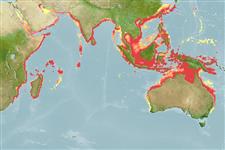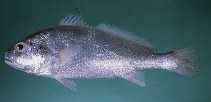Johnius borneensis (Bleeker, 1851)
Sharpnose hammer croaker
Beobachtung melden im Fish Watcher
| Native range | All suitable habitat | Point map | Year 2050 |

|
| This map was computer-generated and has not yet been reviewed. |
| Johnius borneensis AquaMaps Data sources: GBIF OBIS |
Hochladen Photos und videos
Pictures | Google BildJohnius borneensis
Picture by Randall, J.E.
Pictures | Google BildJohnius borneensis
Picture by Randall, J.E.
Viet Nam country information
Common names:
Cá Đù
Occurrence: native
Salinity: freshwater
Abundance: | Ref:
Importance: | Ref:
Aquaculture: | Ref:
Regulations: | Ref:
Uses: no uses
Comments:
National Checklist:
Country Information: https://www.cia.gov/library/publications/resources/the-world-factbook/geos/vm.html
National Fisheries Authority:
Occurrences: Occurrences Point map
Main Ref: Sasaki, K., 2001
National Database:
Occurrence: native
Salinity: freshwater
Abundance: | Ref:
Importance: | Ref:
Aquaculture: | Ref:
Regulations: | Ref:
Uses: no uses
Comments:
National Checklist:
Country Information: https://www.cia.gov/library/publications/resources/the-world-factbook/geos/vm.html
National Fisheries Authority:
Occurrences: Occurrences Point map
Main Ref: Sasaki, K., 2001
National Database:
Common names from other countries
Klassifizierung / Names Namen | Synonyme | Catalog of Fishes(Gattung, Arten) | ITIS | CoL | WoRMS | Cloffa
> Eupercaria/misc (Various families in series Eupercaria) > Sciaenidae (Drums or croakers)
Eponymy: Rev Dr Christoph Samuel John (1747–1813) was a botanist and herpetologist and a medical missionary (1771–1813) at the Danish trading station of Tranquebar (now Tharangambadi), Tamil Nadu, not far from Madras (Chennai). [...] (Ref. 128868), visit book page.
More on author: Bleeker.
Eponymy: Rev Dr Christoph Samuel John (1747–1813) was a botanist and herpetologist and a medical missionary (1771–1813) at the Danish trading station of Tranquebar (now Tharangambadi), Tamil Nadu, not far from Madras (Chennai). [...] (Ref. 128868), visit book page.
More on author: Bleeker.
Environment: milieu / climate zone / depth range / distribution range Ökologie
seewasser; süßwasser; brackwasser benthopelagisch; tiefenbereich 0 - 132 m (Ref. 57178). Tropical; 30°N - 36°S, 32°E - 155°E (Ref. 56999)
Verbreitung Länder | FAO Gebiete | Ecosystems | Vorkommen | Point map | Einführungen | Faunafri
Indo-West Pacific: Persian Gulf eastward to southern China and Taiwan and northern and northeastern Australia and New Guinea.
Length at first maturity / Size / Gewicht / Alter
Maturity: Lm 15.9 range ? - ? cm
Max length : 34.8 cm TL Männchen/unbestimmt; (Ref. 55968); common length : 20.0 cm SL Männchen/unbestimmt; (Ref. 9772)
Max length : 34.8 cm TL Männchen/unbestimmt; (Ref. 55968); common length : 20.0 cm SL Männchen/unbestimmt; (Ref. 9772)
Kurzbeschreibung Bestimmungsschlüssel | Morphologie | Morphometrie
Rückenflossenstacheln (insgesamt) : 10 - 12; Rückenflossenweichstrahlen (insgesamt) : 27 - 32; Afterflossenstacheln: 2; Afterflossenweichstrahlen: 7 - 8. Snout rounded but not swollen or projecting; mouth large, oblique; upper jaw extending backward below posterior half of eye; no barbel on chin; teeth in narrow bands, well differentiated into large and small in both jaws, but none canine-like; gill rakers slender, about half length of gill filaments at angle of arch, 9 to 15 on lower limb. Second anal spine moderately long, 24 to 42 % of head length. Scales on head cycloid (smooth). Swim bladder hammer-shaped, the first pair of arborescent appendages entering head beyond transverse septum and sending a palmate branch to the front of pectoral arch. Sagitta (large earstone) with a tadpole-shaped impression, the head of which has its long axis lying obliquely to that of sagitta and the tail expanded and deepened as a hallow cone connected with the head by narrow groove.
Inhabits shallow coastal waters, estuaries, and rivers. In India, matures at the size of 14 to 16 cm TL; attains an average size of 15.8 cm TL, 20.6 cm TL, and 24 cm TL, at the end of 1 year, 1.5 years and 2 years, respectively. Juveniles prefer crustaceans and as they grow , show piscivorous tendency (Ref. 9772). Marketed fresh and dried salted (Ref. 3490).
Life cycle and mating behavior Geschlechtsreife | Fortpflanzung | Ablaichen | Eier | Fecundity | Larven
Hauptreferenz
Upload your references | Referenzen | Koordinator | Partner
Sasaki, K., 2001. Sciaenidae. Croakers (drums). p.3117-3174. In K.E. Carpenter and V.H. Niem (eds.) FAO species identification guide for fishery purposes. The living marine resources of the Western Central Pacific. Volume 5. Bony fishes part 3 (Menidae to Pomacentridae). Rome, FAO. pp. 2791-3380. (Ref. 9772)
IUCN Rote Liste Status (Ref. 130435: Version 2024-2)
nicht bedroht (LC) ; Date assessed: 27 September 2018
Bedrohung für Menschen
Harmless
Nutzung durch Menschen
Fischereien: weniger kommerziell
FAO(Publication : search) | FishSource |
Mehr Information
Population dynamics
Growth parameters
Max. ages / sizes
Length-weight rel.
Length-length rel.
Längenhäufigkeiten
Mass conversion
Rekrutierung
Dichte
Growth parameters
Max. ages / sizes
Length-weight rel.
Length-length rel.
Längenhäufigkeiten
Mass conversion
Rekrutierung
Dichte
Life cycle
Fortpflanzung
Geschlechtsreife
Fecundity
Ablaichen
Spawning aggregations
Eier
Eientwicklung
Larven
Larven Pop.Dyn.
Fortpflanzung
Geschlechtsreife
Fecundity
Ablaichen
Spawning aggregations
Eier
Eientwicklung
Larven
Larven Pop.Dyn.
Anatomy
Kiemenoberfläche
Brain
Otolith
Kiemenoberfläche
Brain
Otolith
Physiology
Body composition
Nutrients
Oxygen consumption
Swimming type
Swimming speed
Visual pigments
Fish sound
Diseases & Parasites
Toxicity (LC50s)
Body composition
Nutrients
Oxygen consumption
Swimming type
Swimming speed
Visual pigments
Fish sound
Diseases & Parasites
Toxicity (LC50s)
Human related
Aquaculture systems
Aquakultur Profile
Zuchtlinien
Ciguatera cases
Stamps, coins, misc.
Aquaculture systems
Aquakultur Profile
Zuchtlinien
Ciguatera cases
Stamps, coins, misc.
Tools
E-book | Feldführer | Bestimmungsschlüssel | Längenhäufigkeits Tool | Lebensdaten Tool | Punkt Karte | Classification Tree
| Catch-MSY |
Zusatzinformationen
Download XML
Zusammenfassung | Point data | Namen | Photos
Internet Quellen
Aquatic Commons | BHL | Cloffa | BOLDSystems | Websites from users | FishWatcher Einträge suchen | CISTI | Catalog of Fishes(Gattung, Arten) | DiscoverLife | ECOTOX | Faunafri | Fishtrace | GenBank(Genom, nucleotide) | GloBI | GOBASE | | Google Books | Google Scholar | Google | IGFA World Record | MitoFish | Nationale Datenbanken | Otolith Atlas of Taiwan Fishes | PubMed | Reef Life Survey | Scirus | SeaLifeBase | Tree of Life | Wikipedia(Gehe zu, Suchen) | World Records Freshwater Fishing | Zoological Record
Estimates based on models
Preferred temperature (Ref. 115969): 24.6 - 29.1, mean 28 (based on 2424 cells).
Phylogenetic diversity index (Ref. 82804): PD50 = 0.5000 [Uniqueness, from 0.5 = low to 2.0 = high].
Bayesian length-weight: a=0.00490 (0.00326 - 0.00737), b=3.12 (3.00 - 3.24), in cm Total Length, based on LWR estimates for this species & Genus-body shape (Ref. 93245).
Trophic level (Ref. 69278): 3.7 ±0.4 se; based on diet studies.
Widerstandsfähigkeit (Ref. 120179): hoch, Verdopplung der Population dauert weniger als 15 Monate. (K=0.5-0.8).
Fishing Vulnerability (Ref. 59153): Low vulnerability (22 of 100).




